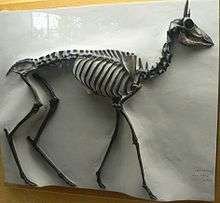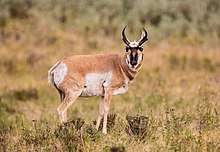Capromeryx
Capromeryx was a genus of dwarf pronghorns (Antilocapridae) that originated in North America during the Pliocene about 5 million years ago (the exact range of their presence on the landscape is still not known, but the most recent fossils found are dated to 11,000 years ago).[1] The closest living relative and only surviving member of the family is the North American pronghorn (Antilocapra americana).[1] Capromeryx furcifer is one of the smallest artiodactlys known, being 24 inches (61 cm) at the shoulder and 25 pounds (11 kg) in weight.[2]
| Capromeryx | |
|---|---|
 | |
| Photo Author: David Monniaux
Photo of a skeleton recovered from the La Brea Asphalt Pits | |
| Scientific classification | |
| Kingdom: | |
| Phylum: | |
| Class: | |
| Order: | |
| Family: | |
| Subfamily: | Antilocaprinae |
| Tribe: | Stockoceratini |
| Genus: | Capromeryx |
Description
Capromeryx were the smallest members of the pronghorn family Antilocapridae. They are recognized by having two upright horns that are conical in shape (wider at the base and tapering toward the top).[3] The United States distribution of this genus includes: Arizona, California, Florida, New Mexico, Texas, and Washington. Fossils have also been found in the Mexican states of: Chihuahua, Sonara, and Baja California.[1] Many Capromeryx fossils have been found in tar pits, and juveniles are especially common. One such location is the Rancho La Brea Tar Pits in Los Angeles, where enough bones have been unearthed to produce a full skeleton sample of Capromeryx minor.[4]
Much like the living pronghorns that exist today, the habitat that these animals were thought to inhabit were grassy plains with some shrubs and large trees for them to take refuge in.[1] It is still unknown what exactly they ate and how they interacted socially but it is speculated that they were similar in many ways to their living relatives, the North American Pronghorn.

Classification
Though the identification of Capromeryx often relies on the basis of tooth size and shape, the description and acceptance of the various species of Capromeryx requires the fossil presence of horn cores (the bony inner shaft of the horn).[5] Some species have not yet produced these cores and therefore have not been recognized as distinct species. Fossil specimens are instead classified by size.[6] Fossils identified as the family Antilocapridae are similarly distributed into genus by size, with Capromeryx being the smallest of the known Pronghorns.[7]
There are several species of Capromeryx, however only four have been formally recognized:
- Capromeryx arizonensis
- Capromeryx furicifer
- Capromeryx tauntonensis
- Capromeryx minor
Some described but unrecognized species include:
- Capromeryx mexicana
- Capromeryx gidleyi
Discovery and species
The earliest fossil records of Capromeryx are dated to 5 million years ago, during the Pliocene, and the most recent are dated to about 11,000 years ago around the time of their extinction. The fossils over time showed a distinct change in size for the Capromeryx, as they started out with larger bodies and distinct two pronged horns with a smaller anterior prong and a large posterior prong, and evolved to become smaller with less distinct horns, where the anterior prong was barely visible due to the decreased size under the horn sheath.[1][8]
The first description of C. furcifer was in 1902 by W.D. Matthew in New Mexico, but it has been found in other locations as well but by other individuals (Hay Springs, Nebraska and La Brea, California are two such locations).[3]
The first description of C. arizonensis was in 1942 by M. F. Skinner also found in New Mexico at two sites called Pearsons Mesa and Caballo.[3] These sites are described as being late Blancan.
James K. Morgan and Neil H. Morgan were the first to describe C. tauntonensis in 1995 in the Journal of Vertebrate Paleontology. They discovered the fossils that included horn cores and teeth during a dig (from 1988 to 1992) in Blancan sediments in Adams County, Washington.[9]
Extinction
Though it is unknown why exactly Capromeryx disappeared from the North American landscape, it is evident that this genus began to decline in diversity around the time of the Late Miocene.[1]
References
- "Extinct Dwarf Pronghorn Fact Sheet". library.sandiegozoo.org. Archived from the original on 2018-05-05. Retrieved 2018-04-03.
- Grayson, Donald (2016). Giant Sloths and Sabertooth Cats : Archaeology of the Ice Age Great Basin. University of Utah Press. p. 116. ISBN 978-1-60781-470-2. OCLC 968727315.
- Lucas, Spencer; Sullivan, Robert (2015). Vertebrate Paleontology in New Mexico. Albuquerque: New Mexico Museum of Natural History & Science. pp. 315–317.
- Wyman, L.E. (1926). Notes on the Pleistocene fossils obtained from Rancho La Brea asphalt pits. Los Angeles Museum of History, Science and Art, Dept. of Natural Sciences; Rev. and amended edition. p. 29.
- Stirton, R. A. (1938). "Notes on Some Late Tertiary and Pleistocene Antilocaprids". Journal of Mammalogy. 19 (3): 366–370. doi:10.2307/1374578. JSTOR 1374578.
- "Capromeryx". www.utep.edu. Retrieved 2018-04-18.
- "Antilocapridae—Pronghorns". Retrieved 2018-04-20.
- Jiménez-Hidalgo, E.; Carranza-Castañeda, O.; Montellano-Ballesteros, M. (20 May 2016). "A Pliocene record of Capromeryx (Mammalia: Antilocapridae) in México". Journal of Paleontology. 78 (06): 1179–1186. doi:10.1017/S0022336000043985. JSTOR 4094944.
- Morgan, James K.; Morgan, Neil H. (14 March 1995). "A New Species of Capromeryx (Mammalia: Artiodactyla) from the Taunton Local Fauna of Washington, and the Correlation with Other Blancan Faunas of Washington and Idaho". Journal of Vertebrate Paleontology. 15 (1): 160–170. doi:10.1080/02724634.1995.10011215. JSTOR 4523614.